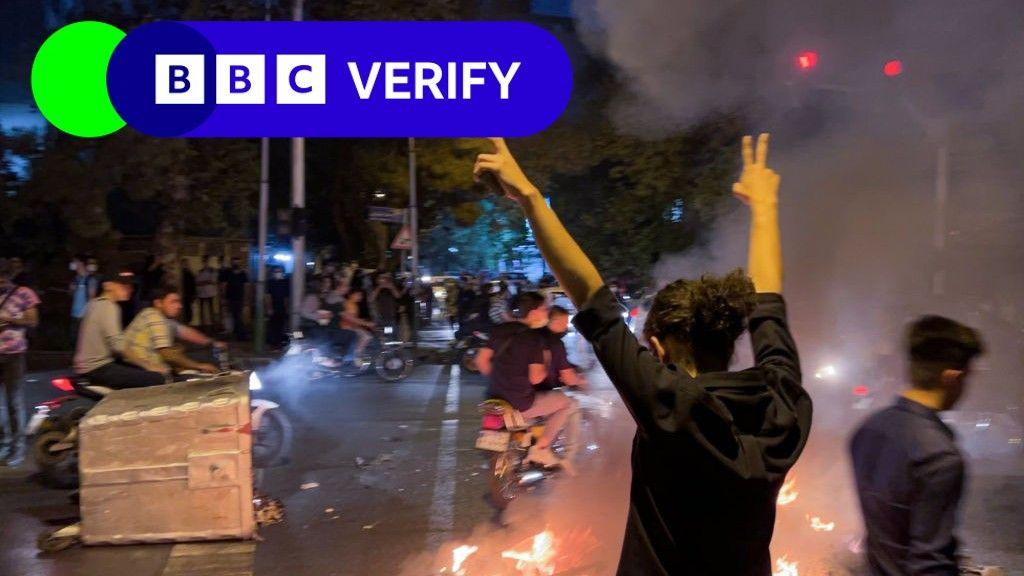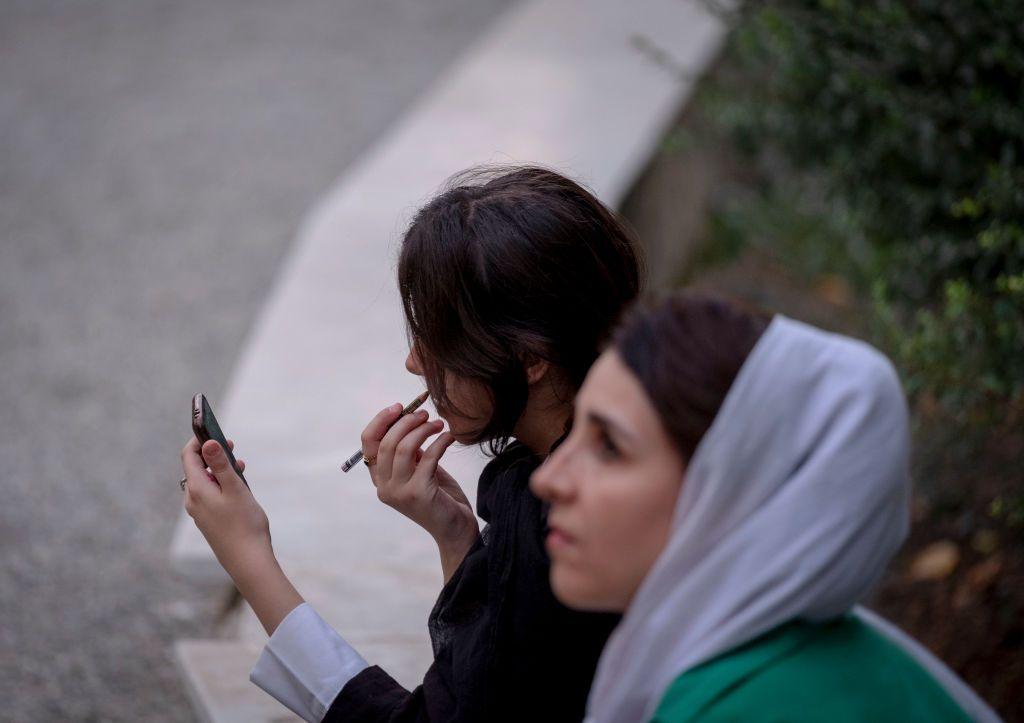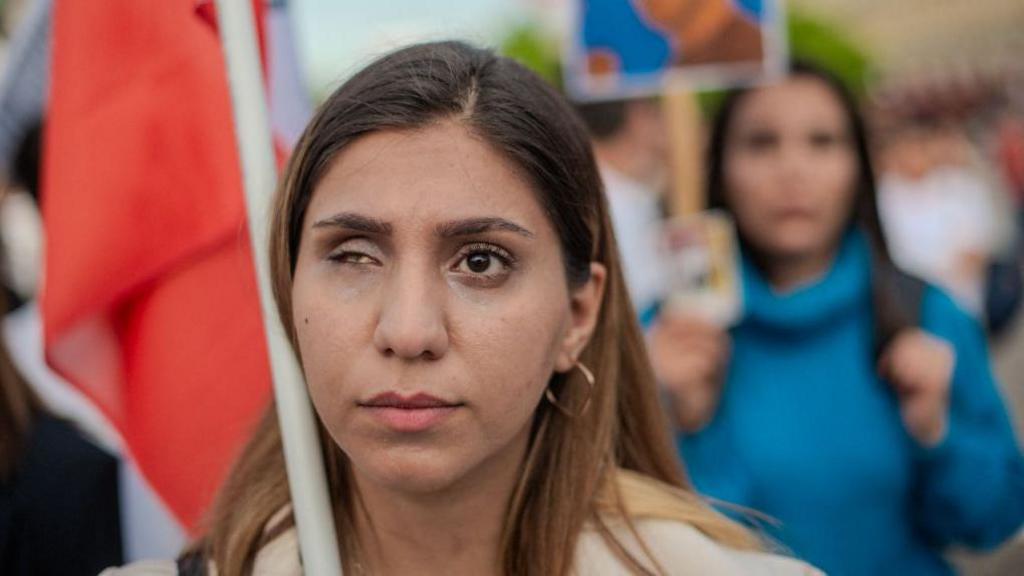'Lashed for a social media photo' in Iran

Protests erupted on the streets of Iran after Mahsa Amini's death
- Published
Women in Iran have told the BBC how their online activity has been spied on by the authorities, leading to arrests, threats and beatings.
Iran stepped up surveillance following nationwide women-led anti-establishment protests, after the death in police custody two years ago of 22-year-old Mahsa Amini, who was arrested for allegedly not wearing her hijab properly.
Warning: The following article contains descriptions of violence. Some names have been changed to protect individuals’ identities.
Like many of the women inspired by the protests, Alef posted a photo on social media revealing her hair flowing freely in public. It was a simple act of solidarity with the movement against the forced wearing of the hijab.
“I didn’t really care enough to hide who I am or where the photo was taken,” she said. “I wanted to say, ‘we exist’.”
But the picture was seen by the authorities, which were trying to crush the protests, and Alef was arrested.
She says she was blindfolded, handcuffed and taken to an unknown location where she remained in solitary confinement for nearly two weeks. She was also interrogated multiple times.
In one interrogation, she says her inquisitors tried to force a confession out of her. She was made to hand over her phone to masked guards, who went through her social media posts and photos. Pictures showed she had participated in protests and that she had been shot at by security forces with pellet guns. Her interrogators also accused her of working for the US.
Alef was charged with, amongst other things, “appearing in public without a hijab” and “promotion of corruption and fornication”.
She was found guilty and although she was given a suspended sentence, she also received 50 lashes.
“A male officer told me to take off my coat and lie down,” she said. “He was holding a black leather whip and started hitting me all over my body. It was very painful but I didn’t want to show weakness.”
Her story was similar to that of two other women and one man we spoke to in Iran. Each told us they were detained and summoned to court for committing “propaganda against the state.” They all received suspended prison sentences. Alef received both a suspended prison sentence and lashes.

Since 2022, many Iranian women have defied the mandatory hijab rule in solidarity with the Woman Life Freedom movement
Jail time
Two of the people we spoke to were held at Tehran’s notorious Evin Prison - known for housing many of Iran’s political prisoners - before being tried and convicted.
Both described poor living conditions in which prisoners were crammed into small, unsanitary and cold cells, with limited access to a shower and toilet, which often led to people falling ill.
A prominent male influencer who was detained for just under a month told us that in his block there was only one shower and one toilet for approximately 100 people.
A woman, Maral, who was jailed for more than two months, said that where she was held the women could only shower once or twice a week. It was particularly tough when they had periods.
“Sometimes they wouldn’t let us go to the toilet for hours,” she said. “If we complained they would say ‘if you co-operate you can leave sooner’. We couldn’t get our hands on period pads. We had to buy them but we had no money, nor would they take money from our family.”
Kosar Eftekhari also had her social media combed through. She was arrested and charged with offences including “propaganda against the state”, “insulting sacred beliefs", “disturbing public opinion”, and “blasphemy”.
One month after Mahsa Amini’s death, Kosar was shot at in her genital area by a riot squad officer with a paintball gun. Moments later he shot her again, this time in the eye “with a smirk on his face”. She instantly heard her right eye “pop” and went blind.
The shocking incident was filmed and posted on Instagram. Despite her injuries and trauma, Kosar became more active online, making her a prime target for heightened surveillance.

Kosar now publicly represents Iranians who have allegedly been shot in the eye by security forces
She says that at her trial, hundreds of her social media posts, including pictures of her without her hijab, were used as evidence by the prosecutor.
Kosar was convicted and sentenced to four years and three months in prison. She was also prohibited from using social media and smartphones for five years.
But to avoid serving time Kosar fled to Germany, where she now advocates for Iranian women on a public level. Earlier this year she spoke to the UN’s Fact Finding Mission on Iran (FFMI) about her experience and what they have called "crimes against humanity".
The FFMI told the BBC “no-one should be jailed for a peaceful post online”.
We put the claims made by the five people we spoke to to the Iranian government but they did not respond. The commander of Iran’s riot police has previously denied his forces intentionally shoot protesters in the face.
Ecosystem of surveillance
Iranian authorities have stifled protests and what they consider to be subversive activities for years, including by increasing state control over people’s lives online.
They have shut down the internet many times and reportedly used phishing techniques to hack phones and access people's data.
Western social media apps like Instagram, X and Telegram are blocked, but many Iranians have bypassed this with tools such as Virtual Private Networks (VPN), which helps them to disguise their location.
The recent wave of protests mainly spread through - and were documented on - these platforms. But as a result of surveillance, tens of thousands of protesters were arrested within the first few months.
A senior researcher at human rights organisation Article 19, Mahsa Alimardani says the majority of protesters were Gen Z and have a large digital footprint, which made “tracking the activities of protesters on social media or through their devices before and during detention” easy.
Authorities have also developed tools to help them, such as an app called Nazer, which allows police and volunteers vetted by the government to report women for not wearing a hijab.
The country has also nationalised part of the internet and incentivised it by making it cheaper to access than the worldwide web. But using it means handing over personal data to the government.

Mahsa Amini's death was a watershed moment in Iran
Two years on Mahsa Amini's death reverberates across the country - and Woman Life Freedom’s digital resistance shows no signs of stopping.
“Now we speak often in our family and friendship circles about our experience of the Woman Life Freedom movement. It’s like the seeds of a flower. Even if a flower withers or dries out, its seeds go on and flower elsewhere,” says Alef.
Additional reporting: Shayan Sardarizadeh
